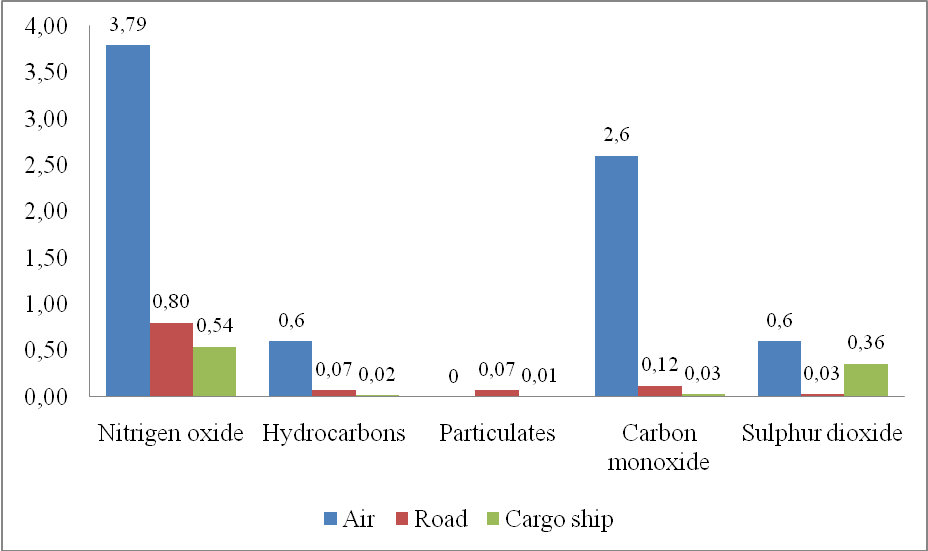
- •Unit 3. The Environmental Impacts of Transportation
- •Vocabulary
- •The Environmental Impacts of Transportation
- •Capacity of urban transport modes per metre of infrastructure width
- •Introduction and thesis statement (Say what you want to do)
- •The body of the paper (Do it)
- •Conclusion (Say what you have done)
- •Supplementary reading Exercise 1. Read the text about the Environmental Impacts of Transportation and answer the following questions.
- •The Environmental Impacts of Transportation
- •Exercise 2. Finish the statement according to the text read.
- •Vocabulary
- •Supplementary reading
- •Popular hard big “green” slow sustainable clean fast high environmentally friendly quiet
- •Read a text about transport - environment link and render it in Russian.
C
Popular hard big “green” slow sustainable clean fast high environmentally friendly quiet
omplete the sentences with the comparative or the superlative form of the adjectives in the box.
Example. Most people believe that of all forms of transport, roads have the biggest impact on the environment.
Russian engineers dream of a high-speed train that will be __________ and ___________ that those in Europe.
For many people in Europe, trains are ____________ form of transport.
Moving goods on canal boats is ___________ than by road or rail, but people and wildlife benefit because it is also _____________.
It is ___________ than you might think to change your motoring habits to help to save the planet.
A hybrid car is __________ than the equivalent of 20 years ago.
As walking is ___________ form of travel, authorities of Scotland encourage people to walk, rather than take the car, to their local shops, school or park.
There are a number of technological decisions, including ________ and __________vehicle with hybrid power system.
The environmental impact of private jets is significantly _________.
Look at the graph and decide if the sentences below are true or false. Correct the false ones. Use the following words: a great deal, a small difference, a little fewer, the highest amount
Example. Road transport is responsible for slightly less carbon monoxide than air travel. F Road transport is responsible for a great deal less carbon monoxide than air travel.
You can see that air travel produces far less pollution than other forms of transport.
Trucks produce slightly less sulphur dioxide than cargo ship.
There’s a large difference in the amount of hydrocarbons released by tracks and ships.
Cargo ships produce a good deal more nitrogen oxides that other forms of transport.
Overall, cargo ships release far fewer exhaust gases than other forms of transport.
Road transport accounts for the smallest amounts of carbon monoxide but the highest amounts of particulates.

Read a text about transport - environment link and render it in Russian.
The relationships between transport and the environment are multidimensional. Some aspects are unknown and some new findings may lead to drastic changes in environmental policies, as it did in regards of acid rain and chlorofluorocarbons in the 1970s and 1980s. The 1990s were characterized by a realization of global environmental issues, epitomized by the growing concerns between anthropogenic effect and climate change. Transportation also became an important dimension of the concept of sustainability, which is expected to become the prime focus of transport activities in the coming decades, ranging from vehicle emissions to green supply chain management practices. These impending developments require a deep understanding of the reciprocal influence between the physical environment and transport infrastructures and yet this understanding is often lacking. The main factors considered in the physical environment are geographical location, topography, geological structure, climate, hydrology, soil, natural vegetation and animal life.
Progress test 3. Keys. Time – 45 min. Total score 50.
Ex. 1. Score 10.
1-I; 2-f; 3-j; 4-a; 5-h; 6-e; 7-d; 8-b; 9-c; 10-g
Ex. 2. Score 8.
1-b; 2-d; 3-a; 4-c.
Ex. 3. Score 10.
faster, more environmentally friendly
the most popular
slower, quieter
harder
greener
most sustainable
cleaner
higher
Ex. 4. Score 12.
F You can see that air travel produces a great deal more pollution than other forms of transport.
T
F There’s a small difference in the amount of hydrocarbons released by tracks and ships.
F Cargo ships produce a little fewer nitrogen oxides that other forms of transport.
T
F Cargo ships account for the smallest amounts of carbon monoxide but road transport accounts for the highest amounts of particulates.
Ex. 5. Score 10.
Possible answer
Отношения между транспортом и окружающей средой многомерны. 1990-е годы отмечены глобальными экологическими проблемами, связанными с зависимостью климатических изменений от воздействия человека на окружающую среду. Сегодня транспорт стал одним из важнейших аспектов концепции устойчивого развития, связанной с деятельностью транспортной отрасли по снижению негативного влияния выхлопных газов и экологически рациональному управлению цепочками поставок. Это потребует глубокого понимания механизмов взаимовлияния физической среды и транспортной инфраструктуры. Основные факторы физической среды: географическое положение, рельеф, геологическая структура, климат, гидрология, грунт, растительный и животный мир.
